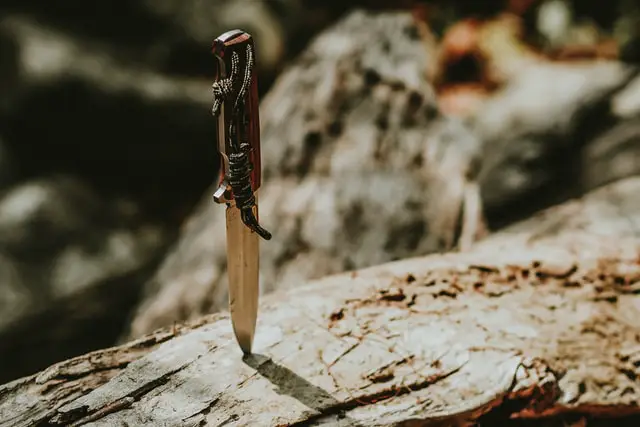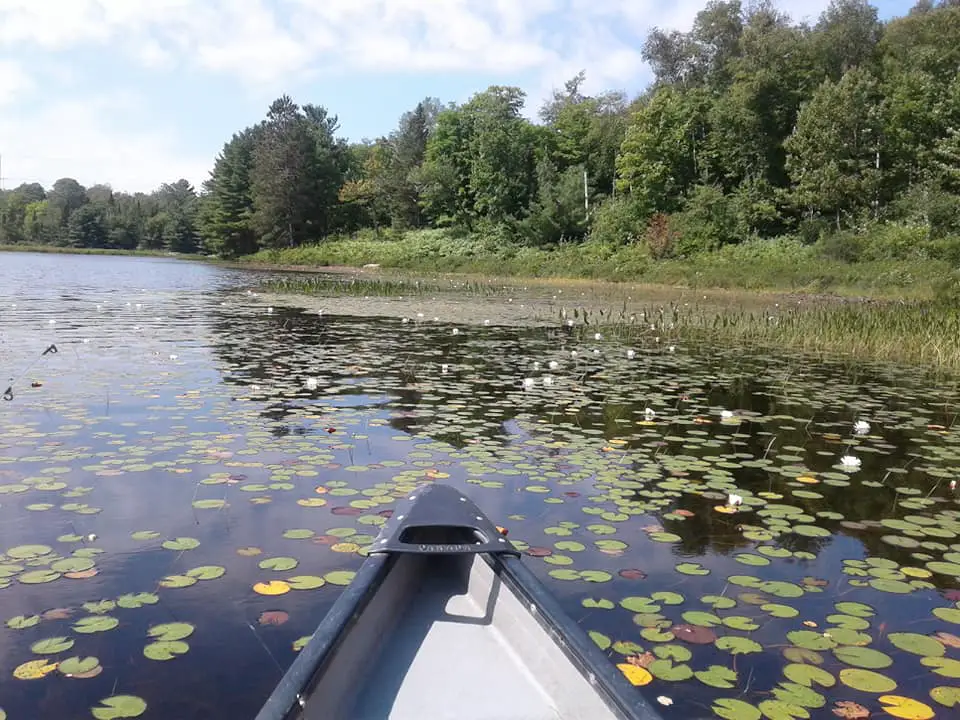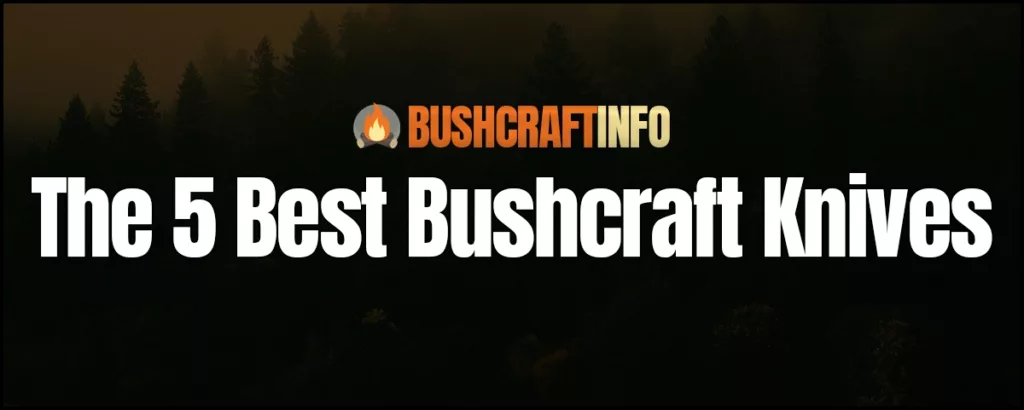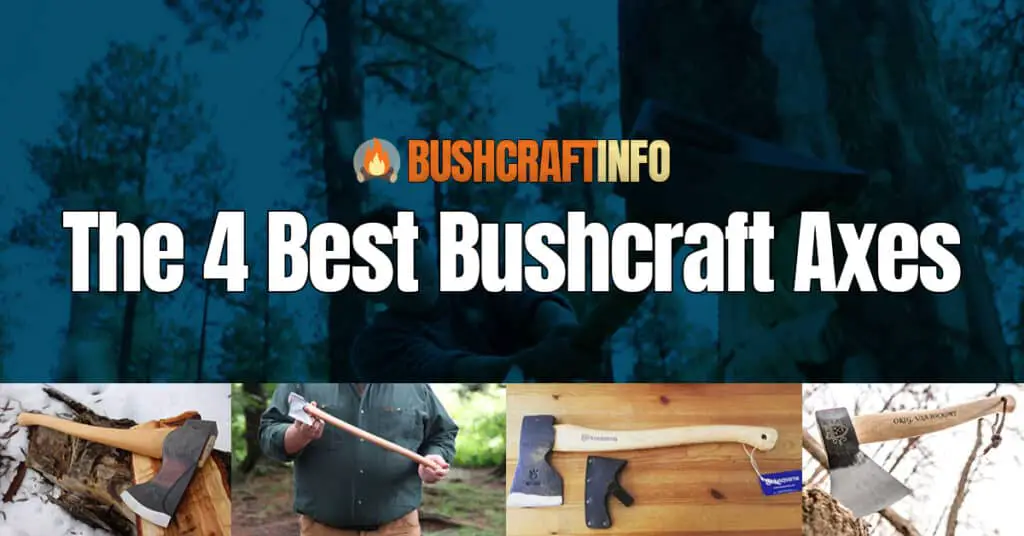Whether you are going camping for a weekend with friends or taking on a much lengthier trip into the bush, this list of 14 items will help prepare you for what lies ahead.
14 Items You Should Have on Your Bushcraft Essentials List
These essential wilderness checklist items are ranked in no particular order but all items on this list are important. Please take your time to read through this bushcraft essentials checklist to really understand the importance of each item and how they can improve your experience in the wilderness.
1. Bushcraft Knife

Very few tools in your rucksack will be more important than a good bushcraft knife. There is a good reason everyone in the bushcraft world carries a knife, it is one of the most versatile pieces of gear I own. A bushcraft knife has many uses, some of those include batoning wood, cutting, skinning, self-defense, carving, digging and so much more. Some important objects you can create with a knife that will serve you in the wilderness are:
- Stakes
- Hooks
- Traps
- Walking sticks
- Spears
- Hooks
- Feather sticks
- Pot hangers
The list could literally go on and on, but you get the idea. There are many different types of bushcraft knives some are full tang whereas some are foldable. Personally, I prefer a good full tang knife as they seem to be more reliable and able to take on the heavier tasks. I do always carry a folding knife in my rucksack as a backup, however.
Choosing your own bushcraft knife is going to be all about personal preference, I have created a list of what I consider to be the 5 best bushcraft knives on the market today that you can use as a guide of sorts to help push you in the right direction.
2. Axe or Hatchet
Speaking of versatile, here is another example of a very versatile bushcraft tool. Using a hatchet you can cut up wood for your bushcraft stoves, shape logs for shelter building, heck you can even make a big wooden spoon with one!
But, for the most part, your axe or hatchet will be used for prepping fuel for your fire or to aid in shelter building. If you venture into the bush without one you are going to have a miserable time trying to gather firewood.
For me personally, I like to carry a smaller hatchet size tool. Simply to cut down the weight of my pack. I actually did a review of the backpacking hatchet I always carry into the bush with me. Feel free to check that out if you are in the market for a new pack axe.
3. Folding Saw
A folding saw is the ultimate bushcraft tool, it can be used for bucking wood or preparing materials for shelter building.
If you have to travel a distance from your camp to find a tree to use as firewood, once you cut it down with your axe it would be a taxing exercise to drag that entire tree all the way back, this is where a folding saw comes in handy. You can buck the wood and carry it back in smaller loads, this is much more efficient.
When packing your rucksack for your next trip it’s important to only take things that won’t weigh you down and are easy to pack, the bushcraft folding saw checks both those boxes as it is lightweight and thanks to it’s folding design, very compact. For being so compact, you would be very surprised how much work these bad boys can get done.
Some people may prefer to pack a bucksaw and I can understand that as it’s all down to personal preference, but I still think it’s more efficient to bring the folding saw.
The big issue with bringing a bucksaw is the depth of your saw often determines how big the trees you can cut are. Why would you want to carry a large bulky bucksaw with you when you could pack a compact folding saw that can take on virtually the same jobs.
4. Ferro Rod
The Ferro rod is one of the most popular ways to start fires in bushcraft, it gives you that invigorating primal feeling of a caveman smashing two stones together to create a flame. Just you know, more efficiently.
Ferro rods are made of Ferrocerium which when struck produces a spark that burns at about 5,430 degrees Fahrenheit even when soaking wet! This makes it an optimal fire starter for outdoor survival situations and is why I have it on my bushcraft essentials list.
They may look intimidating if you have never used one before but don’t worry they are very easy to use. Even if you aren’t practiced in the use of one of these tools you can quickly figure out how to get a fire going without a whole lot of prior knowledge.
I always make it a point to bring a Ferro Rod with me on every trip, I may not use it every single time as it’s just easier to use a bic lighter but it is a great reliable back up to have if my lighter should ever stop working.
5. Lighter
This one here does not require much explanation. Fire is the single most important thing when you are practicing bushcraft. Without fire, you can’t cook your catch, boil water, stay warm at night, or fend off predators that may be lurking in your camp.
What’s the easiest way to create a fire? Thanks to innovation throughout the years you can carry fire in your pocket, well, in the form of a lighter (please don’t try to carry fire in your pocket that sounds like it would hurt).
Lighters should be on everyone’s list of essential bushcraft gear, sure creating fire using a bow drill or Ferro rod is more fun and gives you a better feeling of accomplishment but those things do not always work reliably, and when they don’t you need to be able to reach into your rucksack and grab your trusty Bic lighter.
Not having a lighter with you in the bush is simply not an option.
6. Compass
Next up on the bushcraft essentials list is a trusty compass! With some good fortune, you will never find yourself in a position where you are lost and need to use your compass, but for those situations, it is always a relief to have one in your pack.
Besides aiding in navigation skills, a compass is just as necessary to help you identify directions. Make sure you invest in a compass that is accurate. Along with that, purchase a map of your selected wilderness location. Preferably one with labeling such as roads, railways, water bodies, forests, towns, etc.
Having a compass on you at all times also gives you that extra bit of confidence to be able to go out and explore around your camp in the woods without the fear of forever being lost. I never leave camp without my Suunto M-3G Compass in my haversack.
7. Sharpening stone
What good is a dull blade? No good at all if you ask me! Whether it be your knife or axe, if the blade is dull it’s borderline useless, okay maybe not useless but very aggravating at the very least. Keeping all your bladed tools sharp is essential when in the wilderness.
Sharpening my bushcraft knife has actually become a bedtime ritual when I am out in the bush, it’s a great time killer.
Most nights after I have everything accounted for and done for the day I will sit by the fire and sharpen my bladed tools with my wet stone. This way I kill some time before I am actually ready for bed AND I get to wake up with some sharp tools ready for a day’s work. It’s a win-win.
8. Fishing gear
What happens if you are out in the bush and you run out of food or the food that you packed has been taken by wild animals, what are you going to do? Probably not have a very good time. This is why you should carry some basic fishing gear in your pack.
Even if I don’t plan on fishing at all and stick to my prepared meals each night, I always make it a point to have some bushcraft fishing gear in my rucksack.
It doesn’t have to be a lot, you don’t even need to bring a fishing rod with you. I would suggest you bring a full spool of braided fishing line and a container of hooks.
If all you have is a fishing line and hooks, you are set. You can make trotlines for passive fishing or craft a wooden hand reel and do some hand fishing. The fishing line can also be used for a variety of other things like sewing up equipment or open wounds. If you bring fishing leaders with you, you could even make some snares for wild game.
Fishing gear in any shape or form is something you should always have available in your pack, even if you don’t plan on fishing. Because you never know, this is why it’s on my bushcraft essentials list.
9. Bushcraft Water Filter
When you are out in the wilderness not all water you come by will be clean water, it can oftentimes be full of bacteria, chemicals, and viruses. You need a reliable method of removing these harmful contaminants from your drinking and cooking water.
There are many different kinds of bushcraft water filters, I personally rely on my katadyn vario water gilter to ensure I have clean drinking water at all times.
It’s a little bulkier than some people prefer, but it also does a much better job than most small compact filtration systems and I would gladly take on the minimal extra weight to my pack in exchange for not throwing up or squatting over a hole in the ground for an entire day as the result of drinking bad water.
Water is essential in daily life, so obviously, this is a major item you should have on your bushcraft essentials list.
10. Paracord
The uses for paracord in the bush are virtually endless. The many uses for paracord include:
- Bow Drill cordage
- Shelter building
- Snares for animal trapping
- Fishing line
- Repairing equipment
- Stringing up tarps
Paracord is essential for anyone interested in practicing bushcraft. Let me put it like this. If I was forced to bring two items into the bush with me, it would be my knife and some paracord simply because bushcraft paracord is so vital and has a multitude of uses in the bush.
11. Tarp
A tarp has multiple uses in the world of bushcraft, the main use being: shelter. A tarp shelter is the easiest form of bushcraft shelter you could make and doesn’t take long at all to put together.
Tarps are your ticket to establishing shelter anywhere in the wild. There is no doubt that you need shelter building skills for this, but a tarp is simpler to set up than most methods. A tarp makes things easier for you just as a tent makes it complex. Try to go for a good-quality and lightweight tarp.
They are designed to keep you out of the elements when you are backpacking, camping, etc. When I head out into the bush I prefer to sleep in my hammock as it is lightweight and very easy to set up. To break the wind and keep the rain off of me I always string up a tarp over my hammock.
A tarps main purpose is to keep you dry, staying dry is very important if you plan on having an enjoyable time in the wilderness. When you are wet, it increases your chances to get hypodermic and that can be very, very dangerous.
When you are out camping, backpacking, or on a bushcraft trip it is ESSENTIAL that you bring a tarp with you.
12. Bushcraft First Aid Kit
This one is a no brainer, everyone who heads off into the wilderness should of a basic bushcraft first aid kit with them, in the event you injure yourself you need to be sure you have what you need to take care of the injured area.
Now, you are going to want to customize your first aid kit to suit your medical needs but all basic first aid kits should include:
- Gloves
- Antiseptic wipes
- A multitude of different sized bandages
- Steri-strips
- Antiseptic cream for bites, cuts, or burns
- Hydrocortisone cream
- Disinfectant liquid
- Cotton buds/Q-tips
- Water purification tablets
- Medical tape
- tweezers
- tourniquet
- aspirin
For more bushcraft first aid kit suggestions, I would suggest checking out this very informative wilderness first aid kit list and break down.
If you are looking for a new pre-made first aid kit, I use this AMK mountain series kit which covers you with all the basic items you will need, I also adapted it to suit my personal needs.
No one wants injuries to happen when out in the wilderness, but they do happen. When injuries do occur, you need to be sure you are prepared to deal with them!
13. Bushcraft Rucksack/Backpack
You are going to need somewhere to house all the items on this list of bushcraft essentials. This means choosing the right bushcraft backpack that has space and durability to carry all of your gear.
Your bushcraft backpack has to be durable to last for weeks or months in the wild. Most bags are polyester so that they are tough and do not rip easily. Select a backpack that will offer you maximum compartments to hold most of your tools.
When choosing your rucksack you want to keep these 3 things in mind; Size, space, weight.
14. Pot
Finally, you will need a billy pot or a canteen of sorts.
Not only will you use your pot for cooking up meals, you’ll also be relying on it to help purify your water.
Futhermore, if you are out foraging for berries or other wild edibles it can come in handy as a simply storage container.
Conclusion
For a quick review here are the 14 items you should have on your bushcraft essentials checklist before heading out into the wilderness:
- Bushcraft Knife
- Hatchet
- Folding Saw
- Ferro rod
- Lighter
- Compass
- Sharpening stone
- Fishing gear (Line and hooks)
- Bushcraft water filter
- Paracord
- Tarp
- First aid kit
- Rucksack
- Pot
I hope my list of 14 items for your bushcraft essentials list has maybe helped you discover some items you may be missing when you pack up for your adventure.
I tried to cover only the absolutely essential items to be sure you are prepared for everything in the wilderness because as we know it can be very unpredictable out there and you need to be prepared for every and any situation that may present itself.
Was this post helpful?

Hey I’m Josh! I have been practicing Bushcraft for a little over 6 years now! I Started this website to review awesome bushcraft gear that I love as well as share information I have learned along the way!


